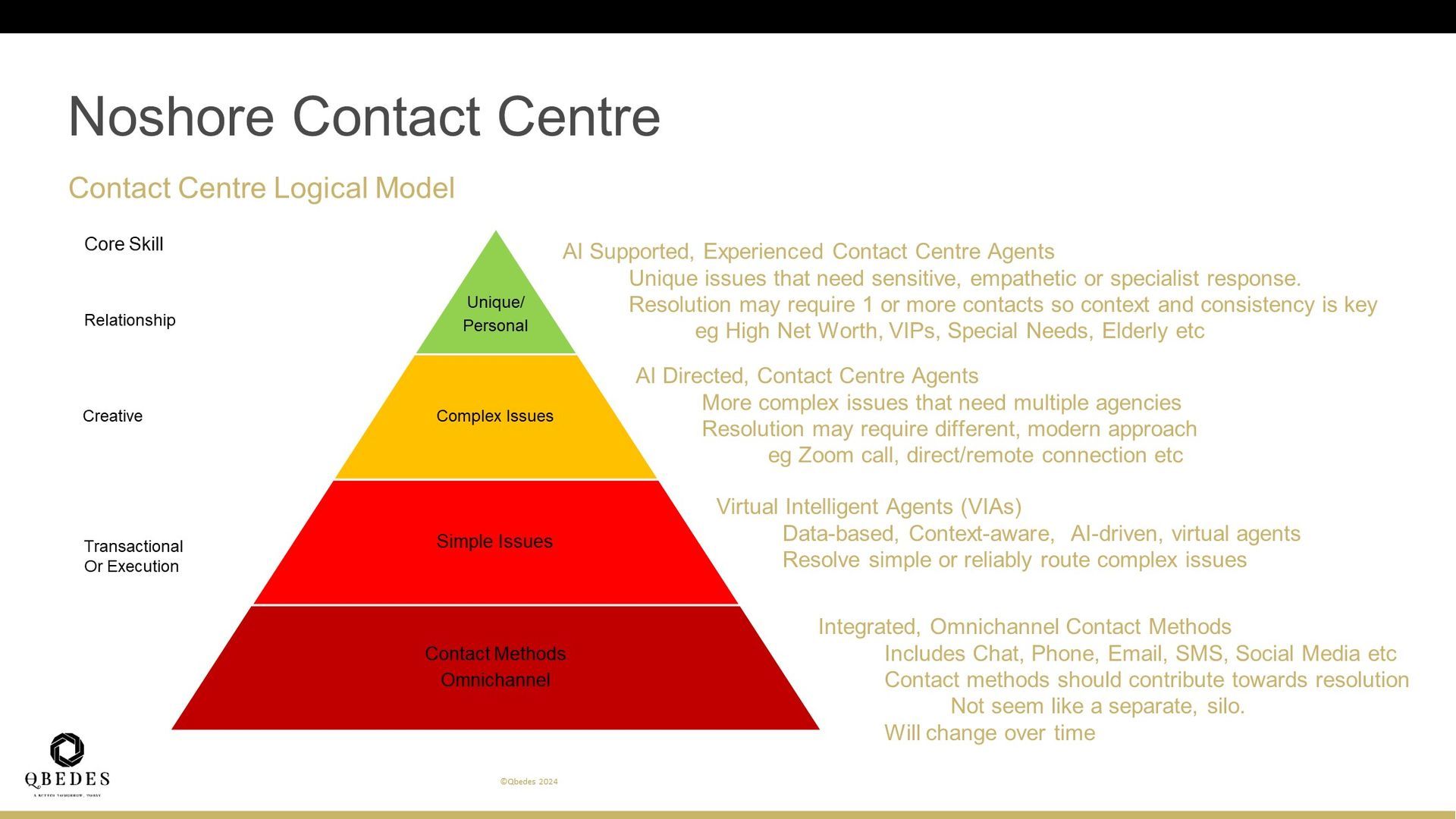Noshore: the coming evolution in contact centres
The future contact centre will be shaped by technological advancements, evolving customer expectations, and new operational models. Buckle up, things are getting interesting!!

The contact centre industry is on the brink of a major transformation driven by technological advancements, shifting customer expectations, and evolving business needs. Previously location was the key driving factor to reduce costs, as high-wage economies looked to offshore contact centre roles to low-wage economies. However, as these economies have developed and became more prosperous, so the wage differential has diminished. Combined with the new opportunities presented by process automation, predictive analytics, GenAI, Cloud, Machine Learning and easier data access, the world of the contact centre is about to radically change as we see the emergence of Noshore contact centres. Noshore contact centres will significantly disrupt the current contact centre environment whilst greatly improving the customer experience. Those contact centre providers that have a Noshore strategy will gain a significant advantage over those who cling to the existing, traditional contact centre model.
Here are the five key trends which enable the Noshore contact centre and deliver a better customer experience at a lower cost.
1. Integration of Artificial Intelligence (AI) and Automation
AI and automation are revolutionising contact centres by streamlining operations and enhancing service quality. AI-powered chatbots and virtual assistants can handle routine inquiries, allowing human agents to focus on more complex issues. This not only improves efficiency but also reduces operational costs. AI can also provide real-time analytics and insights, enabling proactive customer service and personalised interactions.
AI-driven tools can handle routine inquiries and tasks, freeing up human agents to focus on more complex and nuanced issues. This shift not only increases operational efficiency but also reduces costs associated with manual handling of repetitive tasks. Predictive analytics, another AI application, allows contact centres to anticipate customer needs and proactively address potential issues before they escalate.
For customers, AI and automation can provide faster response times and 24/7 support, significantly improving accessibility and convenience. However, the key to success lies in balancing automation with human touch. Customers still value personal interaction for complex issues, supported by GenAI’s ability to summarise lengthy conversations and interactions, so Noshore contact centres provide seamless handovers between virtual and human agents.
2. Omnichannel and Multichannel Support
Customers today expect seamless interactions across multiple channels, including phone, email, social media, live chat, and messaging apps. True omnichannel engagement ensures that customers can switch between channels without repeating themselves, leading to a more coherent and satisfying experience. Thus, Noshore contact centres need to integrate various communication platforms to maintain consistent service quality across all channels.
Implementing a robust omnichannel strategy requires integrating various communication platforms and ensuring that data flows smoothly between them. This integration enhances the ability to track customer interactions across different touchpoints and provides a cohesive view of the customer journey. As communication methods wax and wane over time, it is important that new methods can be supported, and obsolete methods are removed without disruption. It also necessitates investing in technology that supports real-time data synchronisation and cross-channel communication.
Customers benefit from a more cohesive and personalised service experience. They can switch between channels without having to repeat information, and their history is preserved across interactions. This leads to higher satisfaction and loyalty as customers feel their needs are understood and managed consistently. When reaching out to a Noshore contact centre, the customer can use the method most suitable to them at that moment.
3. Enhanced Data Analytics and Customer Insights
Advanced data analytics is becoming increasingly important in understanding customer behaviour and preferences. The number of data sources is growing and the ability to access that data becoming easier. Data is almost everywhere. Derived data for example the phone number or location used to access the contact centre or customer profiles which record the customer’s preferences such as language, preferred name or pronouns, private data about the customers such as products bought, or previous contact history, to publicly available data such social media. Big data, sentiment analysis, and customer journey mapping are tools that help Noshore contact centres glean deeper insights.
Leveraging data analytics enables Noshore contact centres to make informed decisions, optimise processes, and tailor their strategies to meet customer needs more effectively. Analytics can identify trends, measure performance, and predict future customer behaviour, for example frequent calls about a particular issue can allow for more strategic planning and resource allocation, for example, a social media campaign to increase awareness and recommended resolution to pre-empt future calls.
Data-driven insights allow for highly personalised interactions and targeted solutions. Customers receive recommendations and solutions that are relevant to their specific needs and preferences. This level of personalisation enhances satisfaction and fosters a stronger relationship between the customer and the brand.
The figure below highlights the Noshore data model.
4. Focus on Customer Experience (CX) and Employee Experience (EX)
There is an increasing recognition of the interconnection between customer experience and employee experience. Continually dealing with dissatisfied customers creates a negative workplace which adversely impacts employee morale and wellbeing. Offering a better customer experience through the likely benefits of a Noshore contact centre, such as faster response times, higher resolution rates, empathic and appropriate interactions, an emotionally engaged customer journey etc enhances the employee experience and creates a more purpose-driven workplace, as employees can see the difference they make.
Improving employee experience through better training, career development opportunities, and supportive work environments leads to higher engagement and productivity. Engaged employees are more likely to deliver exceptional customer service, which in turn positively impacts customer satisfaction and loyalty, as well as increasing retention rates and making talent acquisition easier.
Noshore contact centres further enhance the customer and employee experience by offering experiences impossible to do with traditional contact centres. Using easier data access personalised rewards can be offered, such as a discount on a future purchase or additional services.
5 More Relevant Implementational Model
Using modern rather than legacy technology offers an easier route to implement a Noshore contact centre. For example, the ability to stand up services in the cloud or use modern APIs to access data means services can be brought online (or taken offline) quickly and easily, with minimal disruption and cost. Remote and hybrid models offer flexible work arrangements to enhance employee satisfaction and operational flexibility, delivering such advantages as reduced overhead costs and access to a broader talent pool.
Noshore contact centres have security (both cyber and physical) designed in as well as sustainability, minimising both physical and carbon footprints. Use of role-based data access ensures data is only accessed by those who need it, and such access is easier to trace and audit. This leads to easier adherence to regulations such as GDPR.
Conclusion
The future of contact centres is shaped by a convergence of technological advancements, evolving customer expectations, and new operational models. AI and automation, omnichannel support, remote work, data analytics, and a focus on both customer and employee experience are pivotal trends that will enable the emergence of the next generation of contact centres. It will no longer be a matter of Onshore, Nearshore or Offshore but Noshore. The adoption of an interactive, Virtual Intelligent Agent to deal with the initial contact and offer either remediation for the simple contacts or appropriate routing for more complex contacts will lead to faster response times and quicker contact resolution time with a higher level of customer satisfaction. Traditional “dead” wait times “You are caller #22 in the queue” will be replaced by a two-way dialogue that not only engages customers but increases the attachment and loyalty to the brand. The Noshore contact centre moves contact centres from a cost centre to a positive marketing tool and potential revenue centre, meaning those brands who stick to or “wait and see” risk being seriously disadvantaged and overtaken by those more forward-looking competitors who embrace the Noshore model.
References
https://gettalkative.com/info/future-of-the-contact-centre
https://www.andrewreise.com/insights/the-evolution-of-contact-centers-top-six-trends-for-2024
https://www.ringcentral.com/us/en/blog/contact-center-trends/
https://www.ttec.com/articles/contact-center-trends-2024



